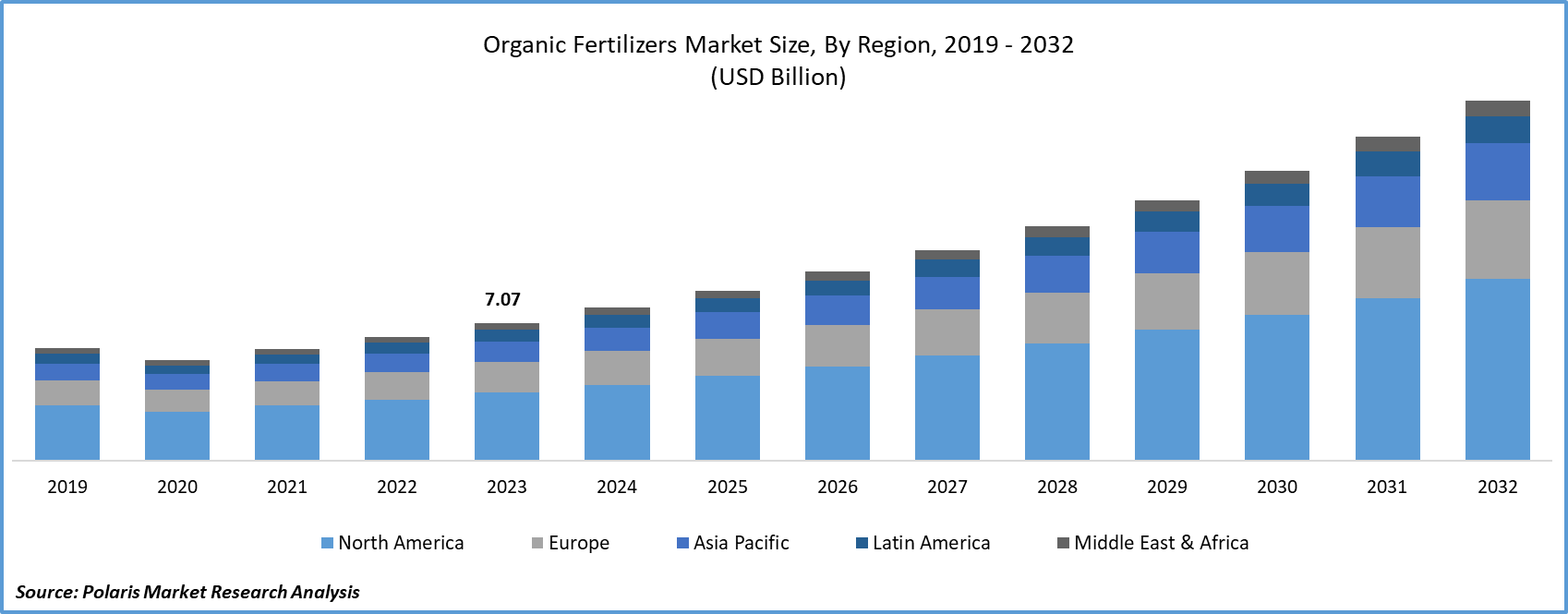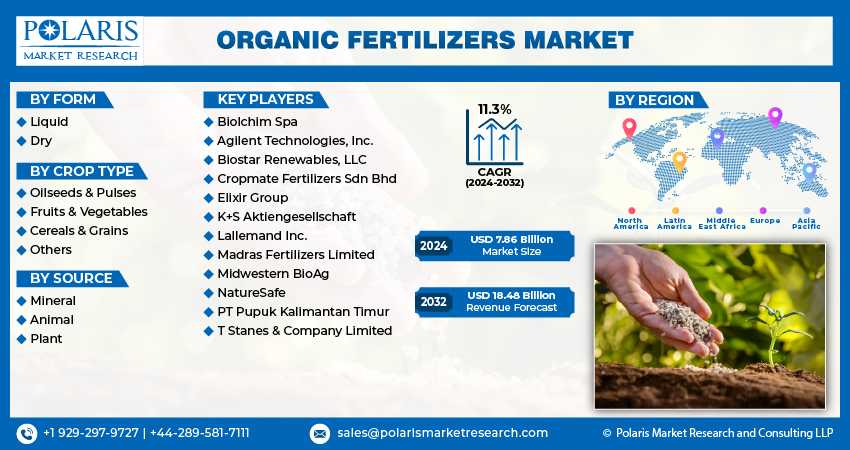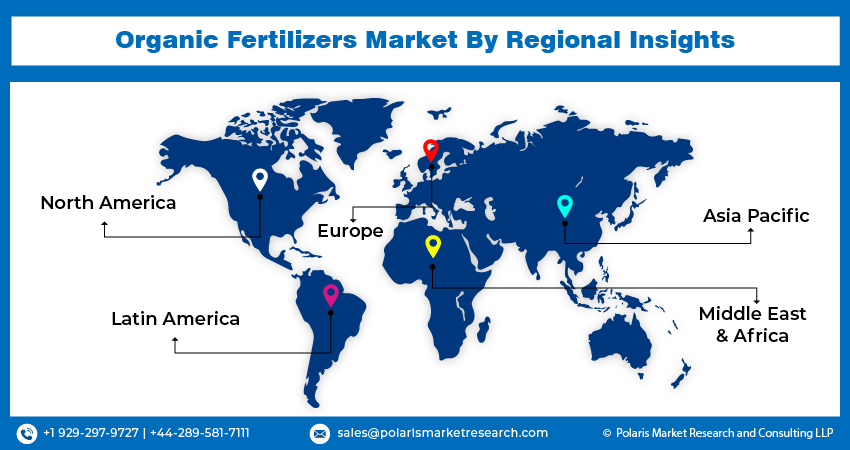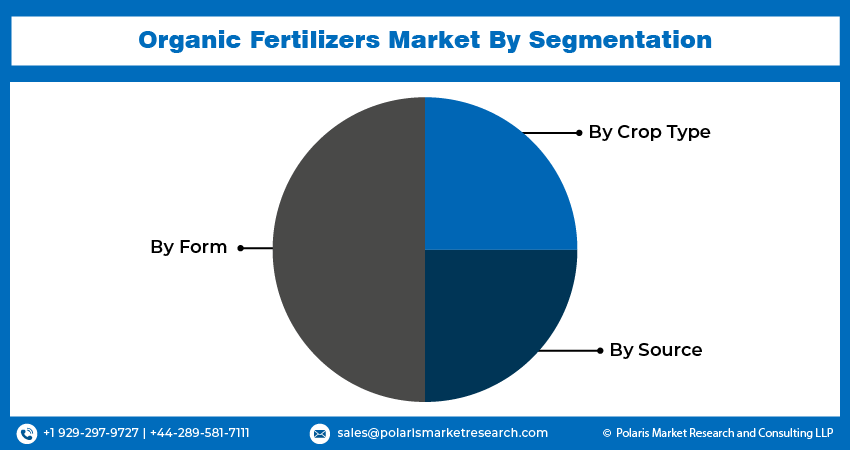
Organic Fertilizers Market Share, Size, Trends, Industry Analysis Report
By Form (Liquid, Dry); By Crop Type; By Source; By Region; Segment Forecast, 2024- 2032
- Published Date:Apr-2024
- Pages: 119
- Format: PDF
- Report ID: PM4871
- Base Year: 2023
- Historical Data: 2019-2022
Report Outlook
Organic Fertilizers Market size was valued at USD 7.07 billion in 2023. The market is anticipated to grow from USD 7.86 billion in 2024 to USD 18.48 billion by 2032, exhibiting a CAGR of 11.3% during the forecast period
Organic Fertilizers Market Overview
Organic fertilizers are natural substances derived from organic materials such as plant residues, animal waste, and compost. Unlike synthetic fertilizers, which are manufactured through chemical processes, organic fertilizers are composed of organic matter that undergoes decomposition to release nutrients gradually. These nutrients include nitrogen, phosphorus, and potassium, as well as various micronutrients essential for plant growth. Organic fertilizers not only provide plants with essential nutrients but also improve soil structure, increase water retention, and promote beneficial microbial activity.

To Understand More About this Research: Request a Free Sample Report
The organic fertilizers market has experienced significant growth in recent years, driven by increasing consumer awareness regarding sustainable agriculture practices and the rising demand for organic food products. As more consumers prioritize health and environmental sustainability, there has been a notable shift towards organic farming methods, fueling the demand for organic fertilizers. Moreover, stringent regulations on chemical fertilizers and growing concerns over soil degradation have further propelled the adoption of organic fertilizers among farmers globally. This trend is reflected in the expanding organic fertilizers market size and the emergence of a wide range of organic fertilizer products tailored to meet the diverse needs of farmers across different regions.
Furthermore, the key organic fertilizers market trends in the organic fertilizers industry is the growing emphasis on product innovation and research and development efforts. Manufacturers are increasingly investing in the development of advanced organic fertilizer formulations that offer improved nutrient content, enhanced soil health benefits, and better crop yields. Additionally, there is a rising focus on developing organic fertilizers with specific nutrient ratios tailored to different crops and soil types, catering to the evolving needs of modern agriculture practices. Furthermore, the adoption of novel production techniques, such as vermicomposting and microbial fermentation, is gaining traction in the organic fertilizers market, offering more sustainable and environmentally friendly alternatives to traditional manufacturing processes.
Additionally, the efforts of both market participants and government entities to promote the adoption of organic fertilizers are expected to propel organic fertilizers market expansion in the coming years. According to European Commission, through their Common Agricultural Policy (CAP) rural growth program, the European government has earmarked 30% of its budget to encourage and support organic farming practices. Organic farming is gaining global traction as it offers a viable alternative to modern agricultural methods reliant on synthetic fertilizers and other artificial techniques. The extensive use of synthetic fertilizers and pesticides has caused significant and widespread environmental damage, thus driving the increased demand for organic fertilizers.
Organic Fertilizers Market Dynamics
Market Drivers
Increasing Consumer Awareness Bolsters the Growth of the Organic Fertilizers Market Share
The surge in consumer awareness regarding the advantages of organic food and sustainable agricultural practices is significantly influencing the demand for organic fertilizers. Consumers are increasingly prioritizing health-conscious choices, seeking produce that is free from synthetic chemicals and pesticides. This heightened awareness stems from concerns about the potential health risks associated with consuming food grown with synthetic inputs and the desire for chemical-free and environmentally friendly options. As a result, there is a growing preference for organically grown food products, which are cultivated using organic fertilizers to maintain soil health and minimize environmental impact.
Moreover, the increasing awareness of sustainable agricultural practices is driving the adoption of organic fertilizers among farmers. With consumers demanding more transparency in food production methods and seeking products that align with their values, farmers are recognizing the need to transition towards organic farming methods. Organic fertilizers play a crucial role in this transition by providing essential nutrients to crops while promoting soil health and fertility. Farmers are increasingly embracing organic fertilizers as part of their commitment to sustainable agriculture, recognizing their role in preserving soil quality, reducing chemical runoff, and contributing to environmentally friendly farming practices.

Market Restraints
Limited Nutrient Content is Likely to Hamper the Growth of the Market
The lower nutrient concentrations in organic fertilizers compared to synthetic alternatives pose a significant hindrance to the organic fertilizers market. This disparity necessitates the application of larger quantities of organic fertilizers to meet the nutrient requirements of crops, resulting in increased application costs and logistical challenges for farmers. The need for larger quantities of organic fertilizers not only elevates operational expenses but also presents challenges in terms of storage, transportation, and handling. Consequently, farmers may be deterred from adopting organic fertilizers due to these higher costs and logistical complexities, preferring the convenience and efficiency offered by synthetic fertilizers with higher nutrient concentrations.
Report Segmentation
The market is primarily segmented based on form, crop type, source, and region.
|
By Form |
By Crop Type |
By Source |
By Region |
|
|
|
|
To Understand the Scope of this Report: Speak to Analyst
Organic Fertilizers Market Segmental Analysis
By Form Analysis
- In 2023, the liquid segment holds a large share of the global organic fertilizers market. This is attributed to the ease of application and rapid nutrient uptake offered by liquid organic fertilizers. Liquid formulations provide farmers with greater flexibility in application methods, allowing for precise and targeted nutrient delivery to crops. Additionally, liquid organic fertilizers are often more readily available for plant uptake compared to solid formulations, resulting in faster nutrient absorption and improved crop performance. Furthermore, the liquid segment benefits from advancements in formulation technologies, enabling manufacturers to develop innovative and highly effective liquid organic fertilizers tailored to meet the specific nutrient requirements of different crops and soil types. As a result, the liquid segment has witnessed substantial growth and widespread adoption among farmers seeking efficient and sustainable solutions for soil fertility and crop nutrition management.
- Over the forecast period, the dry segment is poised for significant growth within the organic fertilizers market. This anticipated expansion can be attributed to several factors, including advancements in manufacturing technologies that enhance the production and formulation of dry organic fertilizers. Dry formulations offer several advantages, such as longer shelf life, ease of storage and transportation, and reduced risk of nutrient leaching compared to liquid alternatives. Additionally, dry organic fertilizers are often more cost-effective to produce and distribute, making them an attractive option for farmers seeking sustainable and affordable soil fertility solutions. Moreover, the growing demand for organic farming practices and the increasing awareness of environmental sustainability are driving the adoption of dry organic fertilizers among farmers worldwide. As a result, the dry segment is expected to experience robust growth as farmers seek efficient and environmentally friendly alternatives to conventional fertilizers.
By Source Analysis
- In the forecast period, the mineral source segment has its dominance in the global organic fertilizers market. This segment's prominence is the widespread availability and accessibility of mineral-based organic fertilizers. Minerals such as gypsum, rock phosphate, and limestone serve as rich sources of essential nutrients such as sulfur, phosphorus, and calcium, vital for plant growth and development. Additionally, mineral-based organic fertilizers offer long-term benefits to soil health and fertility, as they release nutrients slowly over time, promoting sustainable agriculture practices. Furthermore, the mineral source segment benefits from its compatibility with organic farming principles, as mineral-based fertilizers are naturally occurring and do not rely on synthetic chemicals or additives. As a result, the mineral source segment continues to dominate the global organic fertilizers market, catering to the increasing demand for environmentally friendly and nutrient-rich soil amendments among farmers worldwide.
Organic Fertilizers Market Regional Insights
The North America Region Dominated the Global Market with the Largest Market Share in 2023
This dominance can be attributed to several factors, including the region's robust agricultural industry, high consumer awareness regarding organic products, and supportive government initiatives promoting sustainable farming practices. Furthermore, Government policies and streamlined registration procedures in North American nations, such as the United States and Canada, are bolstering the organic fertilizer industry for the long term. For instance, in the United States, registration procedures are conducted at the state level, with biofertilizers classified under soil amendments due to their organic composition.
Similarly, in Canada, the Canadian Food Inspection Agency (CFIA) has established clear and industry-accepted processes for the registration of biofertilizers. This regulatory framework ensures a secure operating environment for biofertilizer companies and facilitates the attraction of new investors to the industry. The supportive governmental policies for organic farming directly contribute to the growth of the organic fertilizers market and are poised to have a lasting impact on the industry.
The Asia Pacific region is anticipated to experience substantial growth in the global organic fertilizers market. The surge in demand is credited to the burgeoning agricultural sector in the region. As per the Food and Agriculture Organization (FAO), the global population is estimated to reach 9.1 billion by 2050, with over half of this populace residing in the Asia Pacific area. This underscores the pressing necessity to bolster agricultural productivity and sustainability to meet the escalating food requirements both locally and globally.
Moreover, the Asia Pacific region holds a pivotal position in the worldwide food trade, accounting for 19% of all food and agricultural exports. Countries like China and India lead the production of key crops such as wheat, rice, cotton, and tea, while Vietnam and Indonesia rank among the top five coffee bean producers globally. Consequently, the expansion of agricultural activities, combined with the increasing demand for chemical-free produce, is poised to propel the organic fertilizer market's growth in the region throughout the projected timeframe.

Competitive Landscape
The organic fertilizers market is characterized by intense rivalry among key players striving for market dominance. Leading companies focus on product innovation, strategic partnerships, and geographical expansion to maintain their competitive edge. These companies invest significantly in research and development to develop advanced organic fertilizer formulations that offer improved nutrient content and efficacy. Moreover, strategic collaborations with agricultural input suppliers, distributors, and retailers enable these players to enhance their market reach and distribution network.
Some of the major players operating in the global market include:
- Biolchim Spa
- Agilent Technologies, Inc.
- Biostar Renewables, LLC
- Cropmate Fertilizers Sdn Bhd
- Elixir Group
- K+S Aktiengesellschaft
- Lallemand Inc.
- Madras Fertilizers Limited
- Midwestern BioAg
- NatureSafe
- PT Pupuk Kalimantan Timur
- T Stanes & Company Limited
Recent Developments
- In November 2023, K+S Aktiengesellschaft and Elixir Group collaborated to open a plant specialized in producing crystalline water-soluble monoammonium phosphate (MAP) fertilizer. This facility is projected to have an annual production capacity of 50,000 tonnes of MAP.
- In July 2023, Agilent Technologies, Inc. (US) acquired Polymer Standards Service, expanding its portfolio for gel permeation chromatography (GPC) and size exclusion chromatography (SEC) in polymer analysis.
Report Coverage
The Organic Fertilizers Market Report emphasizes key regions across the globe to help users better understand the product. The report also provides market insights into recent developments and trends and analyzes the technologies that are gaining traction around the globe. Furthermore, the report covers an in-depth qualitative analysis of various paradigm shifts associated with the transformation of these solutions.
The report provides a detailed analysis of the market while focusing on various key aspects such as competitive methodology, form, crop type, source, and futuristic growth opportunities.
Organic Fertilizers Market Report Scope
|
Report Attributes |
Details |
|
Market size value in 2024 |
USD 7.86 billion |
|
Revenue Forecast in 2032 |
USD 18.48 billion |
|
CAGR |
11.3% from 2024 – 2032 |
|
Base year |
2023 |
|
Historical data |
2019 – 2022 |
|
Forecast period |
2024 – 2032 |
|
Quantitative units |
Revenue in USD billion and CAGR from 2024 to 2032 |
|
Segments Covered |
By Form, By Crop Type, By Source, By Region |
|
Regional scope |
North America, Europe, Asia Pacific, Latin America, Middle East & Africa |
|
Customization |
Report customization as per your requirements with respect to countries, regions, and segmentation. |
FAQ's
The global Organic Fertilizers market size is expected to reach USD 18.48 billion by 2032
Key players in the market are Biolchim Spa, Biostar Renewables, LLC, Cropmate Fertilizers Sdn Bhd, Lallemand Inc
North America contribute notably towards the global Organic Fertilizers Market
Organic Fertilizers Market exhibiting a CAGR of 11.3% during the forecast period
The Organic Fertilizers Market report covering key segments are form, crop type, source, and region.

